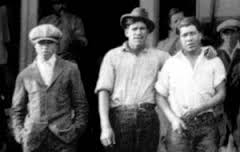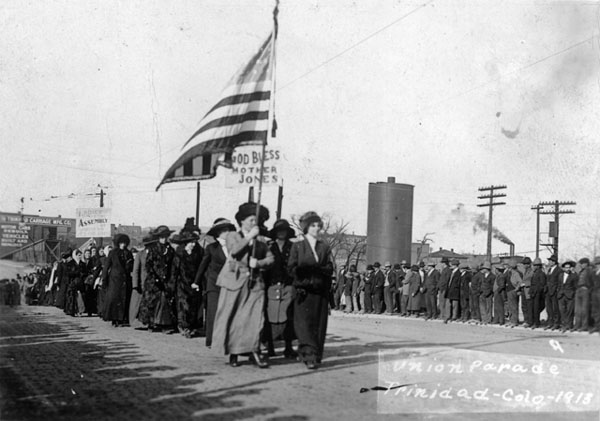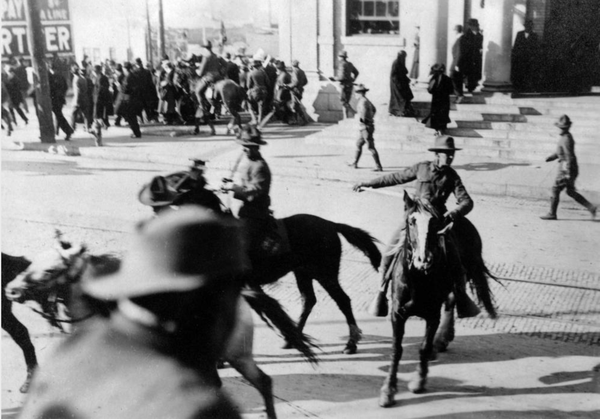2022 Hello , Happy Labor Day weekend! Two things. First, the story of an all-but-forgotten woman who took up the labor fight in Colorado when men leading the strike were arrested. Her actions are recorded for history, but at the time, her name didn't seem important enough to
note. And then, most of you are familiar with my book about Labor Organizer Fannie Sellins, but you may not know that my first published book was also about the labor history.. Fire in the Hole! is set in the silver mining district of Idaho, introducing readers to lesser-known labor wars between miners and management in out west. Not the coal fields of West Virginia and Pennsylvania, nor the copper or coal
mines of Colorado, this story is set in the mountains of Northern Idaho where the ground ran rife with veins of silver.
In this photo you
see the grim faces of strikers outside a union hall in Walsenberg, Colorado, shortly after two striking workers were shot dead by company hired thugs. But you'll never see the face of the woman who took charge when deputies arrested strike leaders. Grim-faced Walsenburg strikers in front of IWW hall where two Wobblies were killed by state police an hour earlier, January 12, 1928. Photo courtesy Wayne State University, provided by Eric Margolis.
The woman is described various ways in an article in the Denver Morning Post, not giving her name but reporting what she said and did. During the winter of 1927-1928 coal miners struck for increased wages and better working conditions at various mines in Southern Colorado and New Mexico. Local authorities tried to undermine the strike by locking up the so-called "ringleaders" and transporting many of them across the state line, threatening to kill them if they returned. In the Walsenberg area, a woman led a crowd of other wives and mothers to storm, demanding to see their husbands and sons. Referred to only as "Mexican mother", a "Indian half breed" and "Mrs. Felix Arrellano" whose husband had been injured in a mine accident. A newspaper headline declared, "Strike Control Passes Into Hands of Women—Hordes of Amazons Storm Jail Demanding to See Deported Sons and Husbands; Mexican Mother
Assumes Leadership With Fiery Speech." Newspaper headlines were longer back in the day. The article went on to say, "If we were asking for diamonds we wouldn't deserve them, but we are asking for bread," said the unnamed woman. And the women are behind her. Their enthusiasm, slow to catch fire at the start of the strike, was fanned to a brisk flame by this wobblie Joan of Arc. Before mine owners finally gave into union demands, half a dozen strikers were shot dead and more than 60 wounded. In the settlement the company refused to recognize the union's a right to bargain in future disputes. It turns out that Mrs. Felix Arrellano represents many women who stood up to support their striking husbands and sons, often risking their lives. Their bravery was typical throughout the many labor wars of the early 1900s. Some 400 women and children march through Trinidad, CO during the 1914-15 United Mine Workers Strike at Ludlow.
In this instance, the woman marched in support of another woman, Mary Harris "Mother" Jones, who'd been arrested as soon as she set foot in town due to her reputation for rallying union members and helping win strikes. Colorado coal miner Louis Bruger said wives played an important role in mine strikes. "They didn't know any more about mining coal than the hog knew about Sunday, but they'd be right up there
giving the men hell for not fighting harder..." Women rallying support during a 1914 strike in Trinidad, CO, were met on the towns Main Street by a cavalry
company of Colorado National Guard. Some 8,000 coal miners had walked off the job demanding a 10 percent pay increase from John D. Rockefeller Jr.'s Colorado Fuel and Iron Company. Below: Women's March, Las Animas County, Colorado. January 1914, Courtesy of Denver Public Library Special Collections
An historical marker at intersection explains what happened. General John Chase riding back and forth on a nervous horse which slipped and
fell. The general lost his seat, his dignity, and his temper. The cavalry surged forward, sabers drawn and bayonets bared.
Falling back, the women threw rocks curses, and screams. In the melee, arms were slashed, feet crushed, and one woman had an ear severed. The marchers finally
scattered. Bitterness grew as the strike continued. Union families had been evicted from company housing, living in tents through the winter. Workers held out. Authorities
brought in machine guns. The dispute came head a few months later on the day after Easter with infamous battle at Ludlow at the tent city a few miles north of Trinidad. After hours of
indiscriminate gunfire, flames broke out and swept through the tents, home to about 1,200 people. Four women and 11 children died in the fire, making news across the country. The Ludlow
Massacre is credited for legitimizing the eight-hour work day and prompting child labor laws. Read details of what happened at Ludlow in this article. A 105-year-old tragedy in this Colorado ghost town shows the true meaning of what we’re celebrating this weekend.
My Dad was in the Ironworkers Union when I was growing up, but my first real experience with labor unions came when I was a TV newsreporter. I covered teachers'
strikes, nurses' strikes, lumber workers' strikes and more. I first visited the Coeur d'Alene Silver Mining District in the early 1980s to report on a steelworkers' strike. I didn't learn the labor history of the area for another decade. That's when I learned to story of a dynamite explosion at a company mill, a "strike train" carrying hundreds of miners into town for a demonstration that culminated in President Willian McKinley deploying US troops to the area. That became the basis for my first novel Fire in the Hole!
Check out this review of the book from the Idaho State Journal: Exciting, riveting Idaho history -
that's what you will find in "Fire in the Hole." Historical fiction at its best, the book sees the miners' wrenching struggle through the eyes of 14-year-old Mick Shea, son of one of the radical and frustrated union employees. The story poses immense problems that build and build through rapid, page-turning sequences. For certain, you will learn a huge amount about a true, almost unbelievable standoff between African-American federal troops that were called in and the striking men who mined for silver in the Coeur d'Alene area. As the cavalry rode into Kellogg, Idaho, authorities arrested every man in the district who had not escaped through the mountains to Montana.
The 600 miners
were locked up in a stockade for three months until the mining companies prevailed in the strike with scab labor and union families left town. Infamous "bullpen" in Kellogg, Idaho, 1899.
The review Fire in the Hole! in the Idaho State Journal wrapped up with this sentence. "This book definitely is one of those can't-put-it-down reads - well written, fast paced and highly informative, to boot. Guaranteed." The book went on to win the Spur Award for juvenile fiction given by the Western Writers of America. The fancy plaque is awarded annually for distinguished writing about the American West and is among the oldest and most prestigious honors in American literature.
So says their website.
Fire in the Hole! was also named a New York Public Library Best Books for the Teenage, a Notable Social Studies
Trade Book for Young People and Bank Street College Best Children’s Books. Unfortunately, the book has gone out of print. I do have a handful of copies in my closet. If you'd
like to purchase an autographed book, let me know. It's $15 plus postage.
Like my article today? Please share:
Sources https://www.hmdb.org/m.asp?m=100500
I have a favor to ask, if you can spare a moment. If you are a member of Goodreads, please click this link to vote for Close Up on War and help gain attention for the book. You'll need to scroll down the list of books to find mine. When I last checked it was #19. Your vote will help more people become aware of
the book.
Follow me on social media
Read a great book? Have a burning question? Let me know. If you know someone who might enjoy my newsletter or books, please forward this e-mail. I will never spam
you or sell your email address, you can unsubscribe anytime at the link below.
To find out more about my books, how I help students, teachers, librarians and writers visit my website at www.MaryCronkFarrell.com.
Contact me at MaryCronkFarrell@gmail.com. Click here to subscribe to this newsletter.
|
|
|








